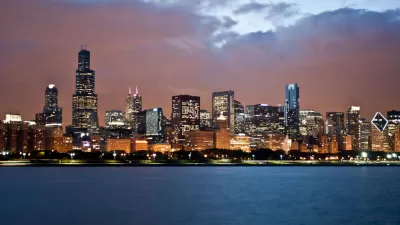After growing in the first half of the decade, some cities might be losing population. Is this because of the pace of immigration has slowed?

Last week, I went to the Congress for New Urbanism in Louisville. One of the most thought-provoking moments occurred on a panel discussing housing trends. The speaker gave the usual patter about how millennials prefer cities and walkable places, and after the speech I mentioned that over the past couple of years, cities have been growing more slowly than earlier in the decade—and in some cases, losing population. The speaker responded that this was a result not of high housing costs or of millennials moving to suburbia, but of declining immigration. Is this true? I decided to look at a couple of cities to at least begin to figure out.
The first question I asked myself: Is immigration really declining? Since most estimates of city and suburban population are based on American Community Survey (ACS) data, I used this data to learn about immigration as well. The number of foreign born persons (including both citizens and non-citizens) was 43 million in 2017, the latest year for which statistics were available. This number is an increase from 41.7 million in 2015, and 40.3 million in 2013. It does not seem like this number has slowed appreciably; the immigrant population increased by 1.4 million from 2013-15 and 1.3 million in 2015-17.
But these, of course, are nationwide statistics. Even if there are more immigrants nationwide, it may be that these immigrants are less likely to settle in urban centers than in the past.
Of the ten largest U.S. cities, all but three (New York, Chicago, and San Jose) have continued to gain population in recent years. According to 2018 ACS data, New York has lost population for two years in a row after gaining people for decades, Chicago has lost population more often than not, and San Jose lost population for the first time this decade in 2018. So if immigration change has truly affected city population, these three cities would be a good place to start (although of course they are no substitute for a statistical deep dive covering a broader sample of cities).
ACS data suggests that in New York City, the number of immigrants increased by about 80,000 people (from almost 3.06 million to 3.14 million) between 2013 and 2015. What happened in the last couple of years? Between 2013 and 2017, the number of foreign-born residents continued to increase, but by only 42,000 people (to about 3.18 million)—a significantly slower increase. (The ACS margin of error was less than 15,000 people in this category, and thus is probably not very relevant.) By contrast, the total population increased by 70,000 from 2013 to 2015, and decreased by over 30,000 after 2015. So there was something of an immigration slowdown, but that slowdown is only partially responsible for the city’s losses.
In Chicago, the foreign-born population has essentially been stable—increasing by 3,000 people from 2013 to 2015, and then decreasing by 9,000 people from 2015 to 2017. At first glance, this 12,000-person turnaround might appear to be responsible for the city’s losses, since the city’s total population declined by about 15,000 people between 2015 and 2017. On the other hand, the apparent decline in immigration might be statistically insignificant, since the ACS’s estimate of foreign-born population is subject to a margin of error of about 5,588 people. In other words, the ACS says Chicago had 563,879 immigrants in 2017, but that could mean the city had as many as 569,000 or as few as 558,000 (rounding up or down a bit). Similarly ,the ACS says Chicago had 572,066 immigrants in 2015, but that number is subject to a 7,049-person margin of error. So its not at all clear that Chicago’s foreign-born population declined at all in the last couple of years.
What about San Jose? In San Jose, the number of foreign-born persons steadily increased: from 373,974 persons in 2013 to 389,090 in 2015 to 403,442 in 2017. By contrast, the city’s overall population rose at a brisk clip in the first half of the decade (by 25,000 from 2013 and 2015 alone) and then has stabilized in recent years. So in San Jose, it seems very unlikely that slowing immigration has affected population growth.
So it appears that inNew York City, immigration was a factor in slow population growth, but not a huge factor. By contrast, it seems unlikely that immigration mattered in San Jose, and unclear whether immigration mattered in Chicago.
All of this assumes, of course, that 1) ACS data is accurate and 2) the past year or two reflects a long-term trend rather than a temporary blip in the data. It is too early to tell whether either of these assumptions are correct.

Trump Administration Could Effectively End Housing Voucher Program
Federal officials are eyeing major cuts to the Section 8 program that helps millions of low-income households pay rent.

Planetizen Federal Action Tracker
A weekly monitor of how Trump’s orders and actions are impacting planners and planning in America.

The 120 Year Old Tiny Home Villages That Sheltered San Francisco’s Earthquake Refugees
More than a century ago, San Francisco mobilized to house thousands of residents displaced by the 1906 earthquake. Could their strategy offer a model for the present?

Alabama School Forestry Initiative Brings Trees to Schoolyards
Trees can improve physical and mental health for students and commnity members.

NYC Outdoor Dining Could Get a Re-Do
The city council is considering making the al fresco dining program year-round to address cost concerns from small businesses.

HSR Reaches Key Settlement in Northern California City
The state’s high-speed rail authority reached an agreement with Millbrae, a key city on the train’s proposed route to San Francisco.
Urban Design for Planners 1: Software Tools
This six-course series explores essential urban design concepts using open source software and equips planners with the tools they need to participate fully in the urban design process.
Planning for Universal Design
Learn the tools for implementing Universal Design in planning regulations.
Ada County Highway District
Clanton & Associates, Inc.
Jessamine County Fiscal Court
Institute for Housing and Urban Development Studies (IHS)
City of Grandview
Harvard GSD Executive Education
Toledo-Lucas County Plan Commissions
Salt Lake City
NYU Wagner Graduate School of Public Service






























